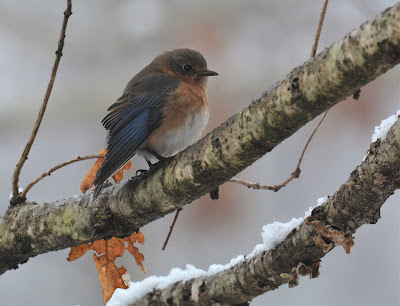A Touch of Winter and Counting Birds
Just five days ago, we were pulling weeds in the garden in short sleeve shirts. During the course of the week we've had torrential rainfall, flooding, tornado warnings, thunder storms and Saturday it started snowing, leaving an accumulation of over 3 inches.
Song birds become very active in such changing weather and it is a perfect time to survey the garden and see what birds are actually out there.
Here are a few from my walk around the garden.
Of course the easiest one to spot is the Eastern bluebird. Both males and females are dressed in bright blue feathers that pop against the subdued greys and browns of the hardwood trees and [currently] the bright white snow.
This bluebird was trying to go unnoticed with its rust colored breast blending in with the red oak leaves that remain on the tree until spring.
In the same red oak tree, a female pine warbler thrashed around amongst the leaves, perhaps searching for insects or seeds dropped from other birds. In winter they often visit suet feeders when other food sources are scarce.
Cardinals are numerous in our woodland and one of the most easily recognized birds. The females are not as brilliantly colored as the males, their brownish orange feathers with just a hint of red trim is understated.
This lady was actively moving from tree to shrubbery in an effort to reach the feeders we put out when temperatures turn fridged. She often rested on limbs, fluffing her feathers to create air pockets for additional insulation to stay warm in the 30 degree morning.
A male house finch, another common backyard bird, steadily perched on a limb, looking a bit nippy. Frankly, I was feeling much the same with frozen fingers trying to manipulate the camera lens.
Song sparrows were low in the vegetation industriously turning up exposed leaf litter as the snow melted. These sweet birds appreciate the grasses and perennial flower heads that we don't cut back until spring so that they serve as a source of food and cover, creating a perfect winter habitat.
Valentine's Day marks the start of the Great Backyard Bird Count of 2020. This is a fun citizen scientist project that anyone young and old can participate in. It's easy. Go to GBBC and set up an account, check out the links with helpful bird identification tips, as well as an online bird guide. You can count multiple times, different locations, and with different groups. Enter your data once you've completed each count.
Why is this project so important? Recent studies have indicated that bird populations are declining significantly. Birds are a critical piece in the natural food web. They are an indicator of the health of our environment. How is your backyard supporting birds? Find out by counting February 14-17.
Song birds become very active in such changing weather and it is a perfect time to survey the garden and see what birds are actually out there.
Here are a few from my walk around the garden.
Of course the easiest one to spot is the Eastern bluebird. Both males and females are dressed in bright blue feathers that pop against the subdued greys and browns of the hardwood trees and [currently] the bright white snow.
This bluebird was trying to go unnoticed with its rust colored breast blending in with the red oak leaves that remain on the tree until spring.
In the same red oak tree, a female pine warbler thrashed around amongst the leaves, perhaps searching for insects or seeds dropped from other birds. In winter they often visit suet feeders when other food sources are scarce.
Cardinals are numerous in our woodland and one of the most easily recognized birds. The females are not as brilliantly colored as the males, their brownish orange feathers with just a hint of red trim is understated.
This lady was actively moving from tree to shrubbery in an effort to reach the feeders we put out when temperatures turn fridged. She often rested on limbs, fluffing her feathers to create air pockets for additional insulation to stay warm in the 30 degree morning.
A male house finch, another common backyard bird, steadily perched on a limb, looking a bit nippy. Frankly, I was feeling much the same with frozen fingers trying to manipulate the camera lens.
Song sparrows were low in the vegetation industriously turning up exposed leaf litter as the snow melted. These sweet birds appreciate the grasses and perennial flower heads that we don't cut back until spring so that they serve as a source of food and cover, creating a perfect winter habitat.
Valentine's Day marks the start of the Great Backyard Bird Count of 2020. This is a fun citizen scientist project that anyone young and old can participate in. It's easy. Go to GBBC and set up an account, check out the links with helpful bird identification tips, as well as an online bird guide. You can count multiple times, different locations, and with different groups. Enter your data once you've completed each count.
Why is this project so important? Recent studies have indicated that bird populations are declining significantly. Birds are a critical piece in the natural food web. They are an indicator of the health of our environment. How is your backyard supporting birds? Find out by counting February 14-17.








.png)
